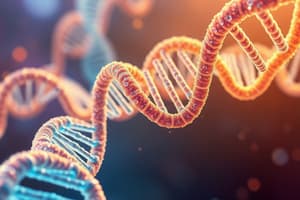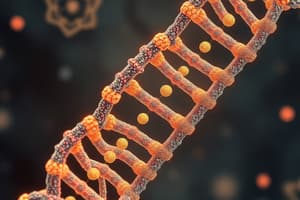Podcast
Questions and Answers
What is the primary function of Type II topoisomerase in relation to helical turns of DNA?
What is the primary function of Type II topoisomerase in relation to helical turns of DNA?
- It changes the DNA by two helical turns. (correct)
- It fixes single-stranded breaks in DNA.
- It introduces positive supercoils.
- It unwinds DNA completely without cleaving.
What effect does negatively supercoiled DNA have on cellular processes?
What effect does negatively supercoiled DNA have on cellular processes?
- It prevents transcription initiation.
- It inhibits DNA replication.
- It promotes strand separation. (correct)
- It facilitates DNA denaturation.
Which of the following describes the end result of Type II topoisomerase cleavage and passage?
Which of the following describes the end result of Type II topoisomerase cleavage and passage?
- It religates both strands of the cleaved segment. (correct)
- It forms a single-stranded break in DNA.
- It prevents DNA tangling.
- It creates two separate DNA molecules.
What is the structure of cellular DNA typically considered?
What is the structure of cellular DNA typically considered?
How does Type II topoisomerase achieve the passage of DNA strands?
How does Type II topoisomerase achieve the passage of DNA strands?
Why is positively supercoiled DNA advantageous for thermophilic organisms?
Why is positively supercoiled DNA advantageous for thermophilic organisms?
What role does reverse gyrase play in thermophilic organisms?
What role does reverse gyrase play in thermophilic organisms?
What happens to DNA during the bind-cleavage (double)-passage-religation mechanism of Type II topoisomerase?
What happens to DNA during the bind-cleavage (double)-passage-religation mechanism of Type II topoisomerase?
What effect do topoisomerases have on DNA supercoiling?
What effect do topoisomerases have on DNA supercoiling?
Which of the following best describes the function of Type I topoisomerase?
Which of the following best describes the function of Type I topoisomerase?
What is produced by each round of catalysis in Type I topoisomerase activity?
What is produced by each round of catalysis in Type I topoisomerase activity?
What is the first step in the Type I topoisomerase mechanism?
What is the first step in the Type I topoisomerase mechanism?
How does the Type I topoisomerase mechanism change DNA's structure?
How does the Type I topoisomerase mechanism change DNA's structure?
What role does the cleaved DNA strand play during the activity of Type I topoisomerase?
What role does the cleaved DNA strand play during the activity of Type I topoisomerase?
Which type of topoisomerase is characterized by cutting both strands of DNA?
Which type of topoisomerase is characterized by cutting both strands of DNA?
What happens during the 'reverse reaction' in Type I topoisomerase?
What happens during the 'reverse reaction' in Type I topoisomerase?
What happens to circular relaxed DNA when it is subjected to positive supercoiling?
What happens to circular relaxed DNA when it is subjected to positive supercoiling?
What role does topoisomerase I play in the context of DNA supercoiling?
What role does topoisomerase I play in the context of DNA supercoiling?
In an agarose gel electrophoresis, how do DNA bands typically migrate?
In an agarose gel electrophoresis, how do DNA bands typically migrate?
What is the visual marker used to stain DNA in agarose gel electrophoresis?
What is the visual marker used to stain DNA in agarose gel electrophoresis?
What condition results in the formation of a negative supercoil in DNA?
What condition results in the formation of a negative supercoil in DNA?
Which type of supercoil is produced when circular relaxed DNA is underwound?
Which type of supercoil is produced when circular relaxed DNA is underwound?
What is the configuration of circular relaxed DNA in terms of helical turns?
What is the configuration of circular relaxed DNA in terms of helical turns?
What would be the effect of applying topoisomerase I to supercoiled DNA?
What would be the effect of applying topoisomerase I to supercoiled DNA?
What is the product of RNA 5’ pApGpCpUpCpGpUpC 3’ after being digested with RNase T1?
What is the product of RNA 5’ pApGpCpUpCpGpUpC 3’ after being digested with RNase T1?
Which statement accurately reflects the action of DNase I on RNA-DNA fusion molecules?
Which statement accurately reflects the action of DNase I on RNA-DNA fusion molecules?
What distinguishes RNase A from RNase T1?
What distinguishes RNase A from RNase T1?
What is a characteristic of alkaline hydrolysis of RNA?
What is a characteristic of alkaline hydrolysis of RNA?
What is the end product of RNA after its hydrolysis by concentrated NaOH?
What is the end product of RNA after its hydrolysis by concentrated NaOH?
What occurs when DNA is supercoiled?
What occurs when DNA is supercoiled?
Which enzyme specifically degrades RNA?
Which enzyme specifically degrades RNA?
In the context of nucleases, what is the difference between an endonuclease and an exonuclease?
In the context of nucleases, what is the difference between an endonuclease and an exonuclease?
What characteristic does negatively supercoiled DNA exhibit in gel migration?
What characteristic does negatively supercoiled DNA exhibit in gel migration?
Which statement about the nature of phosphodiester bond cleavage is true?
Which statement about the nature of phosphodiester bond cleavage is true?
How is the supercoiling state of DNA quantified?
How is the supercoiling state of DNA quantified?
What is a key feature of a nuclease that exhibits substrate specificity?
What is a key feature of a nuclease that exhibits substrate specificity?
What type of cleavage does DNase I produce?
What type of cleavage does DNase I produce?
Flashcards are hidden until you start studying
Study Notes
Topoisomerases
- Topoisomerases alter DNA supercoiling; classified into type I and type II.
- Type I topoisomerases relax DNA by cutting one strand (creating a single-stranded break) and allowing the other strand to pass through before re-ligating the cut strand.
- Each action of type I topoisomerase results in the relaxation of one negative supercoil.
Mechanism of Type I Topoisomerases
- Binds to double-stranded DNA, cleaves, passes the unbroken strand through the break, and then religates the cut strand.
- Each cycle changes the DNA by one helical turn, reducing supercoiling effectively.
Type II Topoisomerases (DNA Gyrase)
- Type II topoisomerases bind to two segments of DNA, cleave both strands at one segment (creating a double-stranded break), pass another segment through the break, and then religate both strands.
- Catalysis results in changes of two helical turns, generating two negative supercoils and aiding in untangling DNA.
DNA Supercoiling
- Cellular DNA is typically negatively supercoiled, promoting easier strand separation which is necessary for replication and transcription.
- Thermophilic organisms contain positively supercoiled DNA, providing structural stability at high temperatures. Reverse gyrase generates positive supercoils in these organisms.
Experimental Analysis of Supercoiling
- Circular DNA supercoiling can be visualized using agarose gel electrophoresis; relaxed DNA moves differently than supercoiled DNA.
- Supercoiled DNA treated with topoisomerase I relaxes to a single supercoil, observable on a gel.
Nucleases
- Nucleases catalyze hydrolysis of phosphodiester bonds in nucleic acids, aiding in DNA and RNA degradation processes.
- Types include ribonuclease (RNase) degrading RNA, deoxyribonuclease (DNase) degrading DNA, and non-specific nucleases acting on both.
- Nucleases vary by position of attack: endonucleases cleave bonds within the chain, while exonucleases cleave from chain ends.
Phosphodiester Bond Reactions
- RNases and DNases produce 5'-OH and 3'-P or vice versa, depending on the specific nuclease.
- Specificity can vary; some nucleases target specific bases while others can act more broadly.
Alkaline Hydrolysis of RNA
- Concentrated NaOH can hydrolyze RNA but does not affect DNA due to DNA's lack of a 2'-OH group, which prevents similar reactions.
- Alkaline treatments lead to RNA denaturation by breaking hydrogen bonds without damaging DNA structurally.
Studying That Suits You
Use AI to generate personalized quizzes and flashcards to suit your learning preferences.




